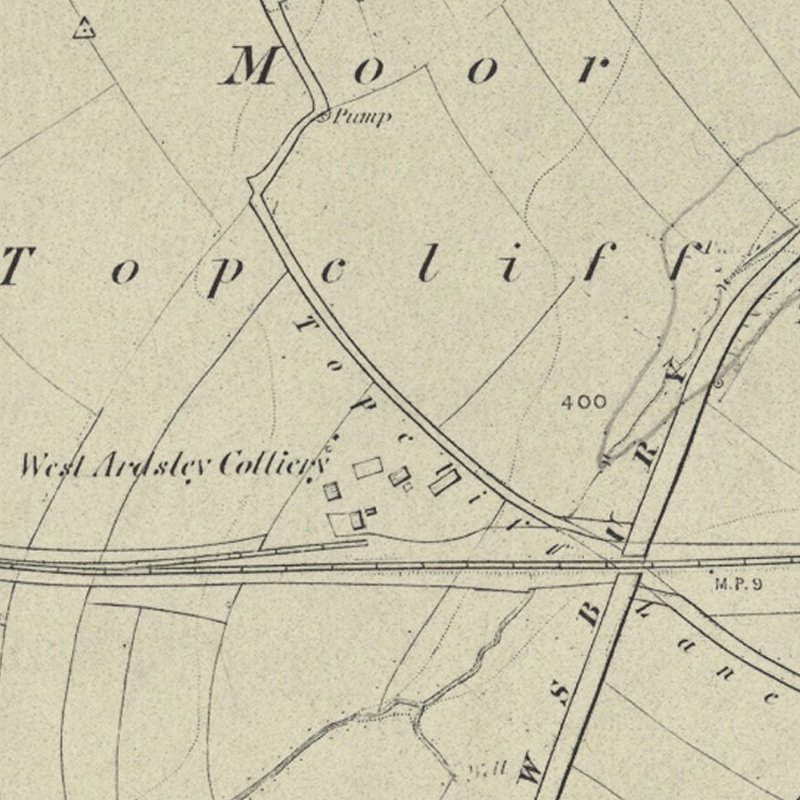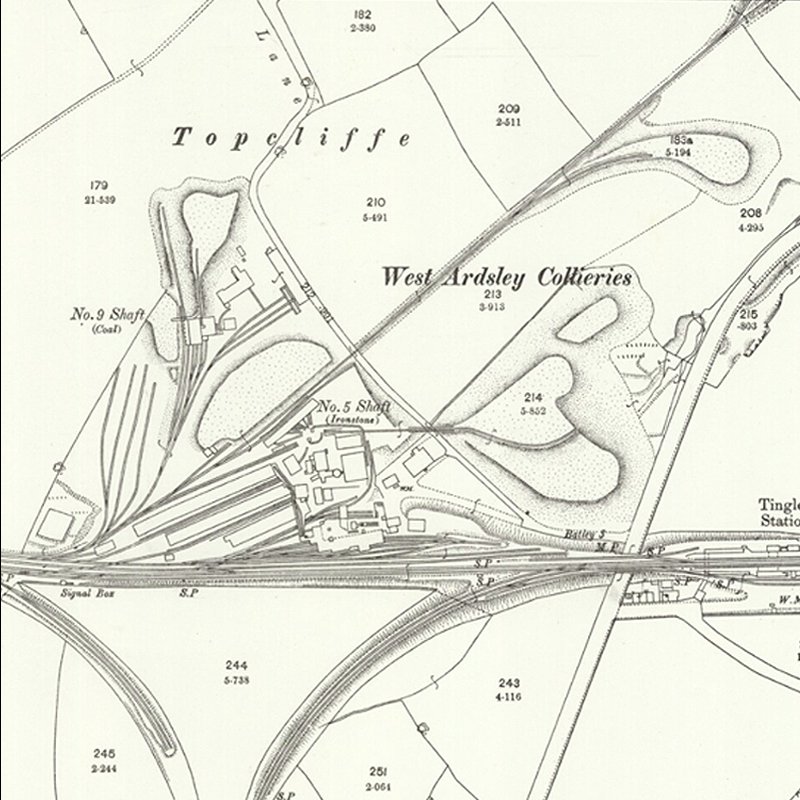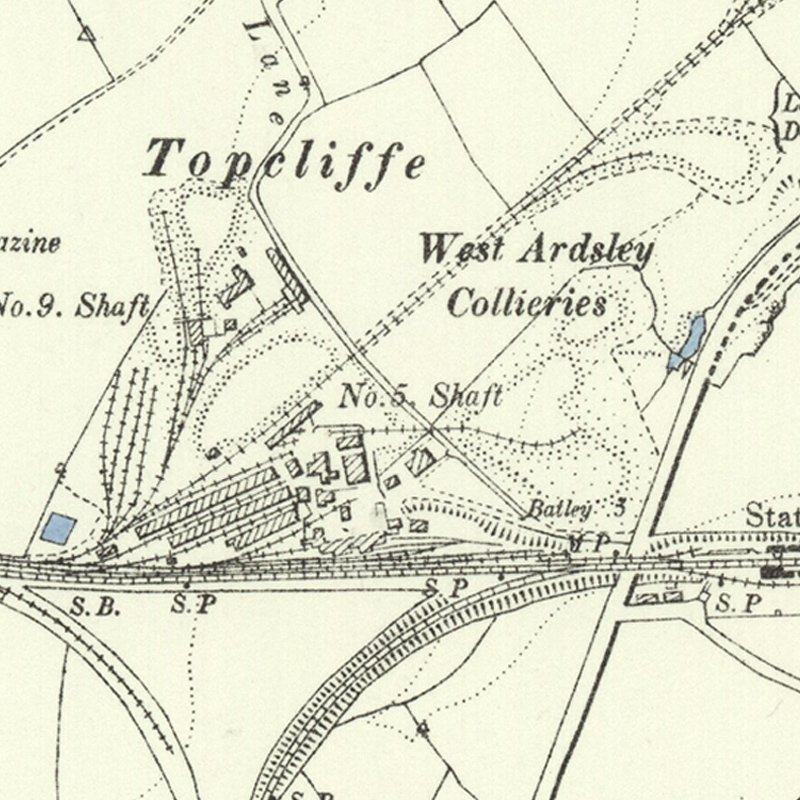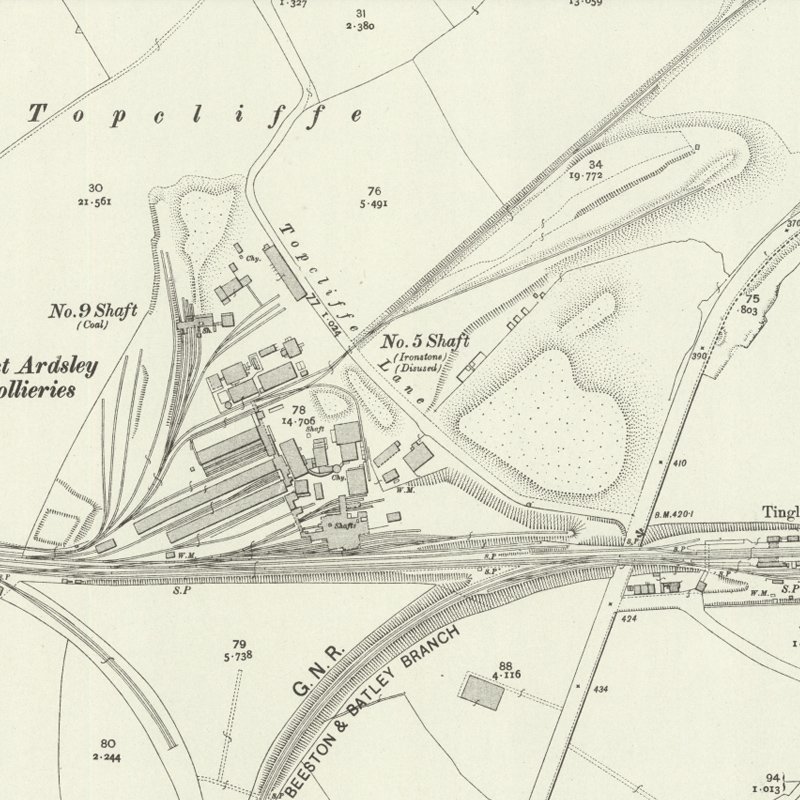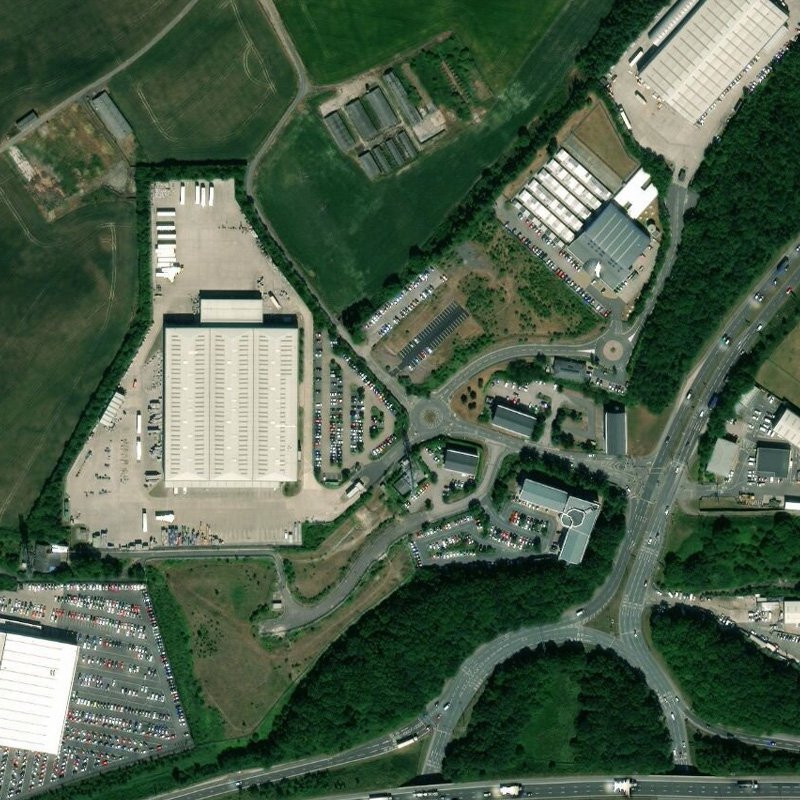West Ardsley Oil Works
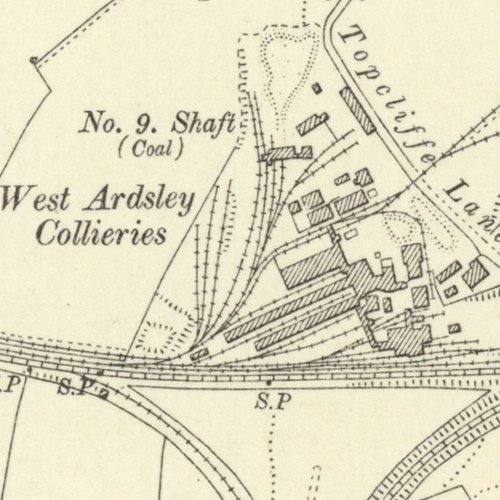
The production of oil was part of an ambitious enterprise which used the latest technologies to produce a wide range of useful products from the iron, clay, coal and cannel mined at West Ardesley. Crude oil was produced from "hub", a shale mined along with the ironstone, which had previously discarded. Little expense seems to have been spared in purchasing retorts and distillation equipment from George Bennie & Co. of Glasgow, and the oil works manager, Mr. Petrie, may also have been a Scot's emigree. A wide range of refined products, from lamp oil to paraffin wax were manufactured and the venture was widely publicised in the local press.
It seems likely that the collapse in oil prices soon made operations unviable, and the costly equipment was auctioned off in 1873.
Mapped by the Ordnance Survey of c.1898, probably following clearance of oil works buildings.
Number of retorts: 30 (in 1869).
The Paraffin and Shale Oil Works at West Ardsley.
Perhaps in no branch of scientific inquiry, pursued in recent years, has more wonderful discoveries been made than in that which has reference to coal and its associated strata. Under chemical manipulation this invaluable mineral now assumes an infinite variety of surprising and beautiful forms, some of the products being of great commercial value. In the minds of most people coal has few out-door associations beyond those which connect it with smoky manufactories, grim-looking blast furnaces, the motive power on railways, and the lighting of our streets. Science, however, like the prince in the nursery tale, has lifted this Cinderella of our national industries from her humble, but highly useful station, and introduced her to the saloons fashionable life. The delicate perfume which refreshes the languid beauty of the heated ball-room, the waxy lights which shed a soft effulgence over the enchanting scene of her night's triumphs, and even the rich colours of her flowing dress, may be only so many of the marvellous forms which it is possible for coal to assume. By its aid the confectioner tempts the youthful appetite for fruity flavours in sweetmeats, and heightens the enjoyment—and swells the doctor's bill —of the juvenile period of our lives.
To revert to the utilitarian aspect of coal, we find it supplying an oil cheaper than gas, and little inferior to it in illuminating power, and yielding in the process of manufacture a waxy matter known as " paraffine scale," in addition to lubricating substance of considerable value. The most familiar objects around pits in the northern coal fields are gigantic heaps of shale and refuse coal, brought from the depths of the mine, and left to take their chance of spontaueous combustion. For years and years past these accumulations were a trouble to the coal-owner, and were regarded as utterly worthless. Now it is discovered that in many cases they possess a commercial value of no insignificant character.
We are glad to find that steps have already been taken in this locality, by an influential and enterprising company, to reap the full benefit of this valuable and important discovery. We refer to the West Yorkshire Iron and Coal Company (Limited), who have established, at their colliery on Tingley Moor—commonly known as West Ardsley—extensive works for distilling coal oil and paraffin from the shale and bastard cannel found in the pit, and hitherto thrown aside as valueless. During a visit to the works, which we had an opportunity of making recently, many highly interesting processes were seen in operation. But, novel and ingenious as these were, there was another feature in connection with the undertaking of the company which was even more worthy of observation. It was the complete utilisation of every product of the mine which was carried out on the spot. Most people have read of the wonderfull adventures a piece of linen after leaving the loom—how, after ministering to the comfort of the well-to-do portion of the community, it may in its adversity fall into low company and come to clothe the shivering form the mendicant; then be cast aside as even unserviceable to him; afterwards be picked out of the dust-bin or the gutter to re-appear, purified from its sordid stains, and recommence its mission of usefulness in the familiar form of paper. Wool, in a similar manner, seems to pass through circle of changes of infinite variety. From broad cloth to rags, from rags to shoddy, from shoddy to broad cloth, and on almost ad infinitum , are processes daily in operation in our midst. This resurrectionary work may not be a pleasant theme for some minds to dwell upon, but of its value and importance there cannot be doubt.
At West Ardsley the products the mine are common coal, cannel coal, bastard cannel, shales, clayband ironstone, and clay. The common coal is made into coke, and used in the blast furnaces of the company for smelting the valuable clayband ore ; the true cannel finds a ready sale amongst gas manufacturers; the bastard cannel and the shales are distilled into spirit, burning oil, paraffin, and lubricating oil, without the expenditure an ounce of coal for firing the retorts, the coke left after distilling the bastard being used for that purpose the clay is made into pressed bricks, which affords another opportunity for utilisation, as the very ashes from the retorts are ground up with the argillaceous material.
Every process is so economically carried out as to make it impossible to put to any substance brought from the mine and say, " This is valueless or wasted." The bastard cannel, or " hub," as it is locally termed, is wrought with the true cannel, and men separate the two at " bank." The "hub" and shale (described as "curly" shales) are conveyed to the retorts, which are situated at a distance of about 20 or 30 yards from the pit mouth. The retorts are iron, and are arranged in what are called benches, containing 25 retorts in each bench. Each retort is charged with about half ton " hub," and distillation commences. It is important that this preliminary process should be carried at a low temperature, or the result would be merely gas, with little chance its condensing into oil. Hence it is that the coke left by the distilled " hub" is better adapted for firing the retorts than coal itself, as it gives that degree of low steady heat required. The oil passes in vapour from the retorts into iron pipes, along several lengths of which it makes a sinuous journey, and, being condensed in the passage, is finally collected in a large tank sunk in the earth.
Each retort is charged once in 24 hours, and the yield of crude oil averages 25 gallons the ton of "hub" or shale. We peeped through the trap door of the tank, and saw a thick, brownish-black, greasy-looking fluid, which seemed to have no affinity with the bright amber-coloured oils and waxy paraffin candles of daily use. The skilful and experienced manager of the works, however, clearly established the relationship before the end of the visit The crude oil is pumped from the subterranean reservoir into an elevated tank, from which the stills are supplied for the first distillation of the crude oil. The stills having done their work, the oil is conveyed to the "agitator," where it is put in violent motion, after the manner of a churn, and at this point the process of purification is assisted by the addition of chemicals. From the agitator the fluid passes into a second sunk tank, is thence pumped into elevated tank, and again into stills, to undergo a second distillation.
At this stage the first separation takes place, by the removal of the true paraffin from the oil. The oil again undergoes the ordeal of the agitator, and is chemically treated for final distillation. It now passes into the refining stills, and at the end of the process the substance treated takes a triple form—spirit, burning oil, and lubricating oil. These are conveyed into separate tanks, lined with lead, and are finally barrelled and sent to market. The paraffin, the first substance separated in the course of distillation, is placed in canvas cloths, and subjected to heavy pressure in a hydraulic press. The lubricating oil retained by the mass is squeezed out, and a light amber-coloured substance, something like beeswax, is left. This is "paraffin scale" It is sold to the candle manufacturers, and used by them in making those beautiful waxy-looking candles, which give such a mellow and brilliant light may mention that the crude oil obtained these works is very rich in paraffin.
From the commencement to the close the process of manufacture, the crude oil, reckoning its journeys from tank to still, and from still to tank, makes a round of upwards of a quarter of a mile in length. The arrangements of the works are so perfect that the oil is passed through the whole of the processes by the aid of a single engine. Mention has been made of the spirit resulting from the separation in the refining stills. This spirit is likely to come into extensive use for burning in the ingenious sponge lamp recently patented. The lubricating oil is much used for greasing the wheels of corves, and in other ways where a cheap grease is a desideratum. A certain proportion of tar is yielded by the distillation. This is sold to the makers of patent fuel. Every product of the manufacture is thus turned to profitable account.
The oil works are under the management of Mr A. Petrie, who has had considerable experience in this branch of manufacture. The many surprising industrial processes to be seen in operation at Tingley Pit, that of brick-making is certainly not the least. By the aid of a most ingenious set of mechanical appliances, clay fresh from the pit can turned into bricks almost faster than they can be carried away. Compared with the rapid rate of production here, the old plan is slow and tedious in the extreme. The clay is ground to powder by broad revolving wheels, set in motion by a steam-engine. As it is ground, the pulverised clay runs into an elevator, composed of numberless small buckets, which carries it upwards and deposits it in the hopper of the brick-making machine. This machine is really a most ingenious invention, both on account of the beautiful simplicity of its movements and the precision with which it executes its allotted task. It would be impossible by mere words to convey clear idea of its construction. We shall content ourselves by stating what we saw it do. The pulverised clay runs from the hopper into four moulds, into which four projecting square-headed parts of the machine descend with the force of a steam hammer. Rising slowly, they rush downwards a second time, and these two tremendous blows convert the dry clay into true-shaped, compact, and homogenous bricks. drying is required, and the workmen hurry oil to the kilns with the bricks as fast the machine turns them out. This machine can produce bricks per day.
Within a few yards from it are live kilns, each capable burning bricks at once. Mr G. Anderson has charge the brickworks. connection with the pit are 32 coke ovens, producing about 200 tons of coke per week the average. Two large kilns are now in course of erection, and when in operation are expected to yield about 400 tons additional per week. The whole of the coke produced will be used at the blast furnaces of the company. At this colliery, which is under the management of Mr S. Whitehead, a very efficient coal cutting-machine, worked by compressed air, is employed, and has been in profitable operation for some time past. An excellent "slack," for engine purposes, is produced at this colliery. In Yorkshire the value the oil bearing shales of the coal measures has only been recognised within a comparatively recent period, and the works at West Ardsley are the first to commence the process of distillation on an extensive scale.
Yorkshire Post and Leeds Intelligencer, 14th March 1868
.......
A Mine of Wealth
On the branch line from Ardsley to Bradford, now affiliated upon the Great Northern system of railways, may be found indicated a small station called Tingley Moor. Though the place may not be particularly well-known to the industrious denizen of our manufacturing towns, it has still a reputation of its own far transcending those of its smoky neighbours, for it was on the Roman road to Castleford, and the evidences of this use of the district have been found from time to time in the neighbourhood of Lingwell Gate. All about the locality coins have been found illustrating the successive reigns of the Caesars, and not only here, but in Leeds itself, evidences are not wanting to show that that highly civilised race were not without their profound appreciation of the mineral treasures under the soil. On the site of the present Corn Exchange, in the Calls "blooms" of Roman origin were discovered when the old tenements were destroyed to make room for the new agricultural emporium ; and the same interesting signs of industry have been recently brought to light in ihe district to which we are now about to call the attention of our readers.
Our first visit to Tingley Moor occurred about six years ago, when we were invited by the enterprising proprietors of the Balaklava Pit to examine for ourselves into the work performed by the iron man. This implement, now pretty well known as Messrs. Firth and Co.'s successful coal-cutting machine, was for the time at work in a portion of the pit nearly a mile from the motive power which gave it its special value and character. It has been considerably improved by Mr. Samuel Firth, son of one of the principal proprietors of the mine, and now it will cut a hole four feet deep at the bottom of the bed of coal. Then there was only one pit on the estate, whilst now there are three. Then the proprietors confined themselves to the profitable working of the coal seams, but now they have found other mineral treasures on the estate, of which it is now our purpose to speak with some little detail: The principal pit, about 160 yards in depth, is the coal mine, properly so called, but in addition to this shaft there is the " little pit " and the "cannel pit." As most of our readers are aware, the cannel coal is very valuable in respect to its gas-yielding properties, but this was also found to be richly coated with a " hub " or shale full of mineral oils. Nearly up to the present time, the shale has been comparatively neglected, as the heaps in the neighbourhood of the several pit-hills in Yorkshire abundantly testify.
So far back as 1847, the existence of paraffin and lubricating oils was first publicly elevated into an important question by Dr. Lyon Playfair, who brought the question under the notice of Mr. Young, of Lime Field, who commenced the manufacture of extracting petroleum from the sandstone bed which lay immediately above the seam of coal, and his enterprise was attended with marked success. He afterwards secured his discovery of the application by patenting it, and the manufacture has since assumed so much importance, that when his privilege expired in 1865, a large number of new establishments were established throughout the north of England, with the object of distilling the oil from the coal. Many of our readers will remember that the carboniferous substance known as Bog-head coal, was brought prominently before the public in the course of the trial of the Torbanehill coal case, in which the lessor of the mine attempted to show that this superior cannel was not coal, and that it did not therefore come within the terms of his lease. But he lost his case because he was unable to show the distinction between cannel and coal, under the terms of the royalty under which he worked the mine. Bog-head coal is very valuable for yielding gas, and for the production of crude oils. Prior to the year 1817, mineral oil was principally collected from streams and wells, and it was not until nearly ten years afterwards that borings were commenced, and systematized efforts made to utilise this product.
By way of showing the development of the enterprise we may point to the fact that whilst in 1861 only about 1,112,490 gallons were exported to Europe from America, in 1863, the quantity reached 28,000,000 gallons. For the time, this influx of American oil had a depressing influence upon the Scotch trade, but now larger works are being carried on successfully with respect to the manufacture of the lubricating material from the shale.
At the West Yorkshire coal and ironstone works, at Tingley Moor, the "hub" is brought up with the cannel coal from the cannel pit. When it reaches the surface, it is conveyed to the furnaces, each retort in which is charged with 10 cwt. at a time. There are fifty of these retorts, this portion of the works consisting of two benches of twenty-five retorts each. These are charged with the shale or "hub" for twenty-four hours, and they yield on an average twenty-five gallons of crude oil per ton. The oil passes from the retorts in a vaporous state, and is then transmitted along iron pipes into a tank sunk under the ground. It is afterwards pumped from this receptacle into an elevated tank, from which the stills are supplied for the first distillation. Subsequently the oil is conveyed to the " agitator," where it is chemically agitated for some time. It next reaches a second sunken tank, and from this it is pumped into another elevated tank, from which the second distillation stills are supplied. The paraffin is separated from the oil at this stage of the process, and then chemically treated for final distillation. The oil is next passed from the agitator into the refining stills, and then comes the separation of the spirit, burning, and lubricating oils. The product is afterwards forced into large wooden tanks lined with lead, where it is barrelled and got ready for the market.
The oil is very rich in paraffin, and the other oils are also prepared for various uses in the manufacturing world. The paraffin is separated from the other oils by a and then it appears in the form of a finely honeycombed waxy mass. This is sent to London to be made into the best quality of candles, and it is another remarkable feature of the arrangements on the estate that all these processes arc quietly accomplished by one small engine, and without requiring the slightest manipulative skill, though the oil travels, in its several courses and stages of purification, through above half a mile of Iron pipes. Corf oil is obtained from the paraffin scales, under the powerful agency of the hydraulic press, and this lubricator finds very extensive demand in the market. The burning oil and spirit also go readily into consumption for various purposes connected with scientific employments. The shale spirit is used with Mr. Teale's lamp, of Manchester, and that of Mr. Clarke, of London.
We have indicated that Messrs. Firth and Co. burn their own "hub," but by way of showing that everything is utilised on this enterprising property, it may be interesting to state, the coke from the " hub" supplies several fires, thereby saving a considerable expense in coal. The "hub," thus converted into coke, gives out a very fine steady heat, without being too strong, and it thereby answers the purposes of fuel even better than coal. In fact, it may be generally stated, and it is art extraordinary fact, that the oil, from the first to the last process, is manufactured without using a single ounce of coal, because the retorts are fired with the coke, and there is then as much to spare as will fire the stills. There is also a market for the tar produced in the process, this being generally eagerly purchased to be employed in the making of patent fuel. The clay out of the pits is also manufactured into bricks on the premises, on the dry-pressing principle : there are five kilns, each of which contains 50,000 bricks. We now pass to the coke ovens, 32 in number, yielding on the average about 200 tons per week, and this arrangement is also made advantageous to the proprietors, because the small coal hitherto left in the pit, or thrown up the "bank," is now converted into a very excellent coke. We have spoken of the shale, the coal, and the clay, but it must not be omitted to name that a good ironstone is also found on the West Ardsley estate- The works for transmuting this metal into gold will shortly he opened. They are the first blast furnaces in this part of UK country, and are constructed on the best scientific principles. In the course of a few days we hope to be able to furnish an account of their formal inauguration.
We are indebted to Mr. Andrew Petrie, manager of the oil works, for the principal facts above embodied.
Leeds Times, 14th March 1868
Extracting Oil, Coal from coal shale in the West Riding.—The West Riding Iron and Coal Company, whose extensive collieries and iron works are situated at East Ardsley and at Tingley, between Leeds and Wakefield, have now no fewer than thirty retorts employed in extracting oil from coal shale. The shale found the seam black coal, or top bed, at a distance 65 yards from the surface. The shale is chipped off the coal at the pit top, and is then taken the retorts, which are charged with it every hour. The vital part the shale passes away in vapour, and is caught by condensing pipes, being thus liquified, and so passed into tanks. It is then pumped into stills, where is chemically treated, and the tar extracted from it. After going through other processes rendered fit for use. Two kinds oil are thus made. The lighter is used lamps, and the heavier for greasing machinery. The sediment placed in cloths and pressed by hydraulic power, after which used for making paraffin.
Paisley Herald and Renfrewshire Advertiser 28th August 1869
.......
PARAFFIN OIL WORKS – TO BE SOLD by private treaty, the whole of the PLANT of the complete and costly PARAFFIN OIL WORKS, belonging to the West Yorkshire Iron & Coal Co. Ltd., situated at Tingley, near Leeds, consisting of retorts, condensers, stills, agitators, refining apparatus, hydraulic tanks, steam engine &c. by Geo Bennie & Co., of Glasgow, with stock of barrels and other articles necessary for the manufacture of oil from shale. Apply to Mr. Chas. Dawson, Secretary, Wallington-street, Leeds.
Leeds Mercury, 15th July 1873


